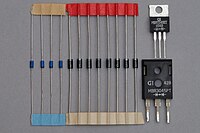
Photo from wikipedia
Very high temperature operation β-Ga2O3 Schottky contacts were fabricated on moderately doped 2 ¯ 01 β-Ga2O3 single crystal substrates using four different types of intentionally oxidized platinum group metal (PGM)… Click to show full abstract
Very high temperature operation β-Ga2O3 Schottky contacts were fabricated on moderately doped 2 ¯ 01 β-Ga2O3 single crystal substrates using four different types of intentionally oxidized platinum group metal (PGM) Schottky contacts (SCs), i.e., PtOx, IrOx, PdOx, and RuOx (x ∼ 2.0, 2.2, 1.1, and 2.4, respectively) formed by reactive rf sputtering of plain-metal targets in an oxidizing plasma. All four types of oxidized PGM SCs showed rectification ratios (at ± 3 V) of more than 10 orders of magnitude up to 300 °C, with almost no measurable increase in reverse leakage current density (Jrev) from that at room temperature. From 350 to 500 °C, a measurable increase in Jrev was observed, which was consistent with the thermionic emission of charge carriers over the respective image force (IF) lowered Schottky barriers. Despite this increase, PtOx(IrOx)[PdOx]{RuOx} SCs showed large rectification ratios (at ± 3 V) of 6 × 106(8 × 106)[5 × 105]{2 × 104} and IF-corrected barrier heights of 2.10(2.10)[1.90]{1.60} ± 0.05 eV, respectively, while operating at 500 °C. The significantly lower 500 °C barrier height of the RuOx SCs was due to the thermal reduction of RuOx to Ru that occurred above 400 °C. In contrast, the Schottky barriers of IrOx, PtOx, and PdOx SCs were thermally stable while operating at 500 °C, indicating significant potential for their use in very high temperature rectifying devices.
Journal Title: Applied Physics Letters
Year Published: 2020
Link to full text (if available)
Share on Social Media: Sign Up to like & get
recommendations!